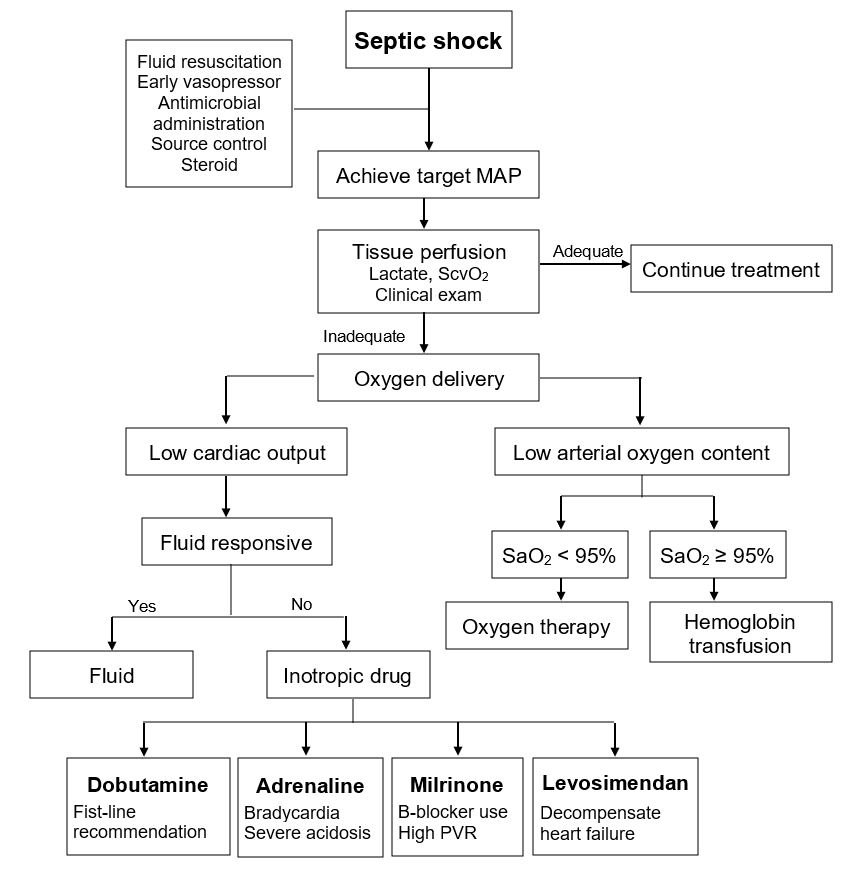Inotropic drugs in septic shock
Inotropic drugs in septic shock
DOI:
https://doi.org/10.54205/ccc.v32.266078Keywords:
Septic shock, Inotropic drugs, Dobutamine, Epinephrine, Phosphodiesterase III inhibitor, LevosimendanAbstract
Septic shock is a life-threatening condition characterized by a complex underlying mechanism that requires a multidimensional treatment approach. Sepsis-induced cardiomyopathy plays a significant role in the development of multiple organ failure. The focus of this review is to determine the evidence-based data of the commonly used inotropic drugs in the management of septic shock during clinical hypoperfusion and reduced myocardial performance. Current guidelines recommend adding dobutamine to norepinephrine or using epinephrine alone in septic-induced cardiomyopathy, while suggesting against the use of levosimendan. Although dobutamine increases cardiac contractility and heart rate, it also decreases systemic vascular resistance. Epinephrine has a greater potency than dobutamine but does not demonstrate a clinical difference in hemodynamic improvement. Milrinone is preferred for cases involving pulmonary hypertension and right ventricular failure but should be avoided in the presence of renal dysfunction. Levosimendan improves cardiac performance and promotes coronary blood flow, but later evidence mentioned significant arrhythmia compared to other inotropic agents. Due to the narrow therapeutic window of these agents, precise therapeutic targets are crucial.
Downloads
References
Cecconi M, De Backer D, Antonelli M, Beale RJ, Bakker J, Hofer C, et al. Consensus on circulatory shock and hemodynamic monitoring. Task force of the European Society of Intensive Care Medicine. Intensive Care Med. 2014;40(12):1795–815.
Evans L, Rhodes A, Alhazzani W, et al. Surviving sepsis campaign: international guidelines for management of sepsis and septic shock 2021. Intensive Care Med. 2021;47(11):1181-1247.
Romero-Bermejo FJ, Ruiz-Bailen M, Gil-Cebrian J, Huertos-Ranchal MJ. Sepsis-induced cardiomyopathy. Curr Cardiol Rev. 2011;7(3):163-83.
Habimana R, Choi I, Cho HJ, Kim D, Lee K, Jeong I. Sepsis-induced cardiac dysfunction: a review of pathophysiology. Acute Crit Care. 2020;35(2):57-66.
Jentzer JC, Coons JC, Link CB, Schmidhofer M. Pharmacotherapy update on the use of vasopressors and inotropes in the intensive care unit. J Cardiovasc Pharmacol Ther. 2015;20(3):249-60.
Dubin A, Lattanzio B, Gatti L. The spectrum of cardiovascular effects of dobutamine - from healthy subjects to septic shock patients. Rev Bras Ter Intensiva. 2017;29(4):490-498.
Rivers E, Nguyen B, Havstad S, Ressler J, Muzzin A, Knoblich B, et al. Early goal-directed therapy collaborative group. Early goal-directed therapy in the treatment of severe sepsis and septic shock. N Engl J Med. 2001;345(19):1368-77.
Enrico C, Kanoore Edul VS, Vazquez AR, Pein MC, Pérez de la Hoz RA, Ince C & Dubin A. Systemic and microcirculatory effects of dobutamine in patients with Septic Shock. Journal of Critical Care. 2012;27(6):630–638.
Hernandez G, Bruhn A, Luengo C, Regueira T, Kattan E, Fuentealba A, et al. Effects of dobutamine on systemic, regional and microcirculatory perfusion parameters in septic shock: a randomized, placebo-controlled, double-blind, crossover study. Intensive Care Med. 2013;39(8):1435-43.
Wilkman E, Kaukonen KM, Pettila V, et al. Association between inotrope treatment and 90‑day mortality in patients with septic shock. Acta Anaesthesiol Scand. 2013;57(4):431–442.
Scheeren TWL, Bakker J, Kaufmann T, Annane D, Asfar P, Boerma EC, et al. Current use of inotropes in circulatory shock. Ann Intensive Care. 2021;11(1):21.
Kislitsina ON, Rich JD, Wilcox JE, Pham DT, Churyla A, Vorovich EB, et al. Shock - classification and pathophysiological principles of therapeutics. Curr Cardiol Rev. 2019;15(2):102-113.
Annane D, Vignon P, Renault A, Bollaert PE, Charpentier C, Martin C, et al. Norepinephrine plus dobutamine versus epinephrine alone for management of septic shock: a randomised trial. Lancet. 2007;370(9588):676-84.
Myburgh JA, Higgins A, Jovanovska A, Lipman J, Ramakrishnan N, Santamaria J; CAT Study investigators. A comparison of epinephrine and norepinephrine in critically ill patients. Intensive Care Med. 2008;34(12):2226-34.
Belletti A, Benedetto U, Biondi-Zoccai G, Leggieri C, Silvani P, Angelini GD, et al. The effect of vasoactive drugs on mortality in patients with severe sepsis and septic shock. A network meta-analysis of randomized trials. J Crit Care. 2017;37:91-98.
Bregagnollo EA, Fortes AH, Cicogna AC. Assessment of inotropic and vasodilating effects of milrinone lactate in patients with dilated cardiomyopathy and severe heart failure. Arq Bras Cardiol. 1999;72(2):149-60.
Barton P, Garcia J, Kouatli A, Kitchen L, Zorka A, Lindsay C, et al. Hemodynamic effects of i.v. milrinone lactate in pediatric patients with septic shock. A prospective, double-blinded, randomized, placebo-controlled, interventional study. Chest. 1996;109(5):1302-12.
Wang Z, Wu Q, Nie X, Guo J, Yang C. Combination therapy with milrinone and esmolol for heart protection in patients with severe sepsis: a prospective, randomized trial. Clin Drug Investig. 2015;35(11):707-16.
Jentzer JC, Coons JC, Link CB, Schmidhofer M. Pharmacotherapy update on the use of vasopressors and inotropes in the intensive care unit. Journal of Cardiovascular Pharmacology and Therapeutics. 2015;20(3):249-260.
Sato R, Ariyoshi N, Hasegawa D, Crossey E, Hamahata N, Ishihara T, et al. Effects of inotropes on the mortality in patients with septic shock. J Intensive Care Med. 2021;36(2):211-219.
Kasikcioglu HA, Cam N. A review of levosimendan in the treatment of heart failure. Vasc Health Risk Manag. 2006;2(4):389-400.
Morelli A, Teboul JL, Maggiore SM, Vieillard-Baron A, Rocco M, Conti G, et al. Effects of levosimendan on right ventricular afterload in patients with acute respiratory distress syndrome: a pilot study. Crit Care Med. 2006;34(9):2287-93.
Zangrillo A, Putzu A, Monaco F, Oriani A, Frau G, De Luca M, et al. Levosimendan reduces mortality in patients with severe sepsis and septic shock: A meta-analysis of randomized trials. Journal of Critical Care. 2015;30(5):908–913.
Morelli A, De Castro S, Teboul JL, Singer M, Rocco M, Conti G, et al. Effects of levosimendan on systemic and regional hemodynamics in septic myocardial depression. Intensive Care Med. 2005;31(5):638-44.
Gordon AC, Perkins GD, Singer M, McAuley DF, Orme RML, Santhakumaran S, et al. Levosimendan for the prevention of acute organ dysfunction in sepsis. New England Journal of Medicine. 2016;375(17):1638–1648.
Annane D, Ouanes-Besbes L, de Backer D, DU B, Gordon AC, Hernández G, et al. A global perspective on vasoactive agents in shock. Intensive Care Med. 2018;44(6):833-846.

Downloads
Published
How to Cite
Issue
Section
License
Copyright (c) 2024 The Thai Society of Critical Care Medicine

This work is licensed under a Creative Commons Attribution-NonCommercial 4.0 International License.




